Replacement windows are the gift that keeps on giving. There are so many benefits of replacement windows, including giving your home a facelift, increasing the value of your home, and saving you money on utility bills. If your windows are outdated, drafty, or rotting, it may be time to consider replacement windows. At E&E Contracting, we are experienced with a wide variety of windows; let’s take a look at some of our favorite types of windows to install for our customers.
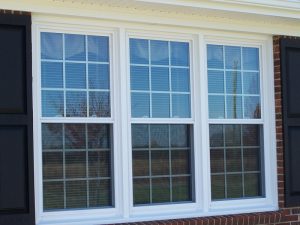
This style of window is the most common, and what most people picture when they think of residential windows. Single hung windows are typically rectangular or square in shape, and have two window sashes. They open vertically from the bottom, and the top sash remains stationary.
Double hung windows have the same appearance, but with a few added benefits. Both the top and bottom sash can be opened, and they typically have the ability to tilt in and out for easy cleaning. This is the most popular replacement window style and we love installing them in our customers’ homes.
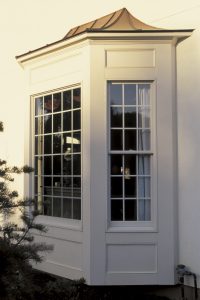
Bay windows are a stylish choice that bring in tons of natural light and add a point of interest to your home’s exterior. Bay windows protrude from your home and leave a large window sill or window seat on the inside. They usually consist of one large showcase window in the center and a smaller window on each side.
At E&E we have replaced our customers’ existing bay windows, but we can also add bay windows to almost any home. To install a bay window the home needs to have at least 6.5 feet of free space, and interior space to accommodate the window seat or sill. Contact us today to discuss adding a bay window to your home!
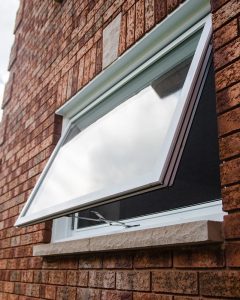
Awning windows are a great option for people looking for the natural light and ventilation of a window, but with some additional privacy. They have the ability to be placed higher on the wall which maximizes wall space, and offers more privacy on the inside. Awning windows open outward using a top hinge. When opened the glass serves as a top shield, which means they can be open even when it is raining.
Awning windows work great in areas that require privacy and may have limited wall space. We love adding them to our customers’ kitchens and bathrooms to provide extra light and privacy.
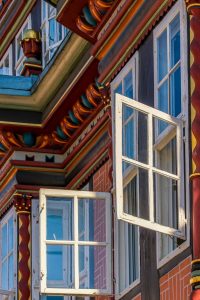
Casement windows operate in a similar way to awning windows, but they open outward via a hinge on the side. They are also called crank windows, because they are operated with a handle that cranks the window open. We love using casement windows in areas where it may be difficult to open a single or double hung window. Areas like over a sink, or tight bathrooms are great locations for casement windows.
Casement windows can also be used to complement a bay window. Placing casement windows on the far sides of a bay window can allow you to get as much ventilation as possible, and prevent you from having to reach over the larger window sill to open them.

Transom windows are a little different than the window styles we have already discussed; they are accent windows typically found around doors or entryways. They are rectangular or circular in shape and offer a beautiful accent to exterior and interior doors, while also bringing natural light into the home. They can appear on the door itself, and can also be used on the door frame to wrap the door.
At E&E we love using transom windows to enhance the new doors we install for our customers. Contact us today to discuss our replacement door options!
Are you interested in upgrading your home with replacement windows? Contact us today for a complimentary quote!
Home additions are big projects that cost tens of thousands of dollars, depending on the scope. No matter the size, you need to finance the project. Here are some popular ways to finance your home addition.
Before you figure out how you will finance your home addition, you need a general understanding of how much your project will cost. Many popular additions have an approximate price range to help you understand how to finance them. For example, a small project, like enclosing a porch, will cost only a few thousand dollars. A big project, like an in-law suite, could cost around $90,000 to $120,000. Check out our guide to see how much your project may cost.
If you plan ahead with something like a 5- or 10-year plan for your home, you can start setting aside some cash every month towards a home addition. This method will be the cheapest in the long run, as you won’t have to worry about interest. The downside to saving cash is that it takes time. Depending on the scale of your project and how much you can afford to set aside every month, you could have to wait decades before your project can even begin.
Check with your contractor to see if they have a financing partnership with a financial institution. These special financing options have competitive rates when compared to independent financiers because of the partnership with the contractor. Often, you’ll receive a revolving line of credit that you could use for multiple projects or to cover hidden costs that arise during construction.
If you’ve lived in your home for several years, you likely own a significant amount of equity in your home. You are able to leverage this equity to secure a Home Equity Loan (HEL) or Home Equity Line of Credit (HELOC). Both options are essentially second mortgages, but are used in different ways. The benefit is that these have lower interest rates than a personal loan or credit card. The downside is that you need to own enough equity in your home to receive the funds.
HEL is a lump sum of money you’ll receive immediately to pay for your addition. Since you receive the money immediately, you’ll start making payments on the loan immediately, too. These payments will be on the principal and interest.
HELOC is a revolving line of credit, similar to a credit card, that you can draw money out of up to a maximum amount. They are more flexible than a HEL because you’ll only draw out what you need when you need it. You’ll have a draw period for when you can use this line of credit. During this time you only need to pay interest, and principal payments are optional. At the conclusion of your draw period, you’ll be required to make payments on interest and principal.
A different option to leverage your home equity is by refinancing your home. You’ll be “cashing out” by replacing your current mortgage with a new one at a higher amount than what you currently owe. The difference between your new mortgage amount and the amount owed on the old mortgage will be cash in your hand to use on your addition. A cash-out refinance is more convenient than HEL or HELOC because you’ll only be making one payment a month, but you should only consider this option if you can secure a new mortgage at an equal or lower interest rate than your current mortgage.
If you don’t have enough equity in your home to justify one of the options above, you can still apply for a personal loan or a personal line of credit. The financial institution will take into consideration your income and credit history to determine how much to loan to you. Just like with a HEL and HELOC, a loan is a lump sum while a line of credit functions similar to a credit card. Be wary, however, when using a personal loan or line of credit. These often have the worst interest rates and you’ll likely be better off using the promotional rates of your contractor’s partnership with a financier.
If you’ve already talked to us about your home addition project and need financing before we get started, check out our financing page. We partner with Wells Fargo Home Projects for special financing options for E&E Contracting customers only! If you’re not that far along in the process and still need to talk to a representative, contact E&E Contracting online today!
Asphalt shingles have been one of the most popular roofing materials in the US for decades, and we love using them to give our customers’ homes a durable and stylish refresh. Despite asphalt shingles being a popular roof choice, we find that many of our customers aren’t familiar with the material and come to us with a lot of questions. Today we are going to do a deep dive on asphalt shingles so you can decide if they are the right material for your upcoming roofing project.
Asphalt shingles were originally developed in the early 1900s as an alternative to cedar shingles. At this time asphalt shingles were similar to asphalt roll roofing, where a felt or cloth roll was coated in asphalt. Soon, manufacturers began to add slate granules for texture and durability. As the years went by and roofing technology continued to advance, there are now lots of asphalt shingle options to suit your needs. Below we have outlined the most popular styles of asphalt shingles available today.
Three tab shingles are made from a fiberglass material and coated with asphalt. These materials are put onto a roll, and cut into 3 equal tabs that offer a clean and uniform finish. These are the most affordable asphalt shingle option, but they can be less durable than some of our other favorite options.
Architectural shingles were developed after three-tab shingles, and expanded on the design to increase durability and style. Architectural shingles are made with multiple layers of asphalt coated fiberglass that are laminated together, and cut together differently for a more stylistic finish. They are an incredibly durable option, and often come with some great warranty options.
Designer shingles don’t differ from architectural shingles in their construction, but offer unique color and style options to make your home pop. Many designer shingles will resemble cedar or slate shingles, which is a great option for homeowners who love the style of these older roofing materials, but want the durability of asphalt shingles.
There are lots of shingle brands out there, and at E&E Contracting we choose to work with GAF Shingles. GAF has been innovating the asphalt shingle industry for over 100 years, and in our experience their asphalt shingles provide homeowners with the best durability and style in the industry. GAF’s innovation doesn’t just stop at the shingle; they also manufacture top class leak barriers, roof deck protection, and ventilation and attic vents. We love using all of these products to create a roof that is built to brave whatever nature has in store for your home.
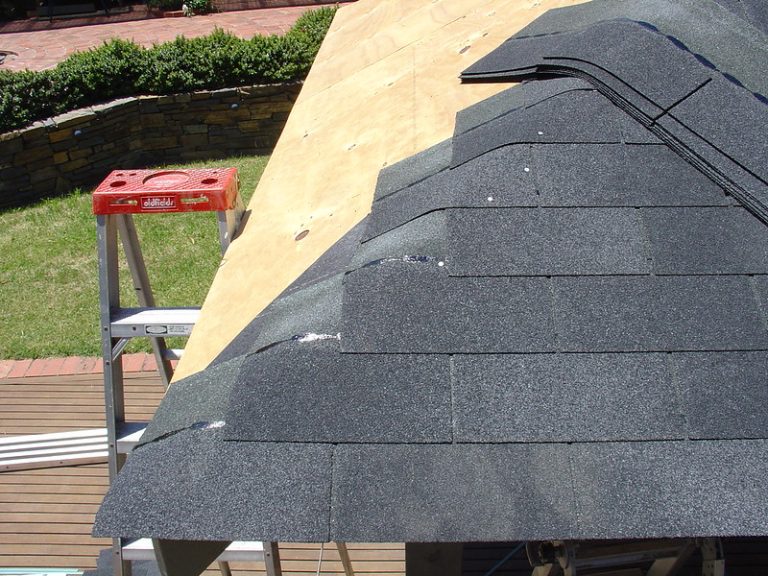
This is the most common question we get about asphalt shingles, but there is no set expiration date for asphalt shingles. Home location, climate, exposure to weather and sun, and other factors can cause variations in the durability of the material. That being said, most asphalt shingle brands come with a warranty that guarantees their product for a certain number of years.
GAF’s warranty is one of the best in the industry, offering a limited lifetime warranty on their shingles. They also have a variety of other warranties associated with their shingles, including algae, a 130 mph wind warranty, and warranties that cover their leak barriers and other products.
If you are unsure if your roof needs new shingles, we recommend a roofing inspection, and you can also check out some signs that you may need a new roof.
We’ve talked a lot about the durability of asphalt shingles, but how much do they cost? Surprisingly, asphalt shingles are one of the most affordable roofing material options out there. According to Home Guide, homeowners can expect to pay between $80-$250 per square foot on their next roofing project.
This price can be affected by the shingle brand and style you choose, the contractor, and the size/intricacy of your roof.
Are you ready to take on an asphalt shingle roofing project? The team at E&E Contracting would love to speak with you, contact us today for a complimentary quote!
Synthetic slate roofing, also known as composite roofing, has grown in popularity over the last 25+ years despite its existence in the United States since the early 1900s. Today, this roofing material is loved for its high durability, stylish appearance, easy maintenance, and money-saving features.
The success of synthetic roofing depends on the materials used and the way it’s designed. When compared to other synthetic slate roofing brands, DaVinci’s synthetic slate wins by a landslide. Keep reading to see all the reasons we recommend this US-based brand.
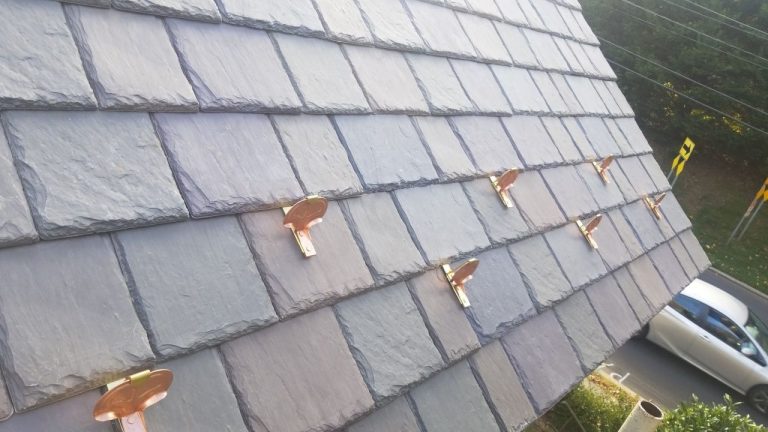
DaVinci synthetic slate tiles are made from engineered polymer and virgin resin. These materials create roof tiles that are fire-retardent, heat-resistant, and protected against UV exposure. Unlike natural slate tiles, synthetic slate tiles aren’t susceptible to rotting, chipping, cracking, breaking, or damage from wildlife and insects. These synthetic tiles are also protected against fungi, mold, and algae.
A common issue with natural slate is how heavy it is. Natural slate is so heavy that it frequently requires additional roof support during installation. DaVinci synthetic slate tiles solve this problem by being lightweight and easy to install. Because of its lightweight properties, synthetic slate roofing can be used for almost any type of house. Best of all, synthetic slate roofs are low-maintenance while being considerably cheaper and longer lasting than natural slate roofing.
Part of the aesthetic appeal of synthetic slate roofing is how realistic it looks. DaVinci’s synthetic slate tiles mimic the style of natural slate roofs with chisel marks and grooves. To do this, DaVinci creates molds from natural slate. These molds then produce tiles that are non-repeating and look like genuine slate. While DaVinci’s synthetic slate tiles are not made with recycled materials, the tiles themselves are 100% recyclable.
Additionally, DaVinci offers “Cool Roof Colors” that don’t absorb heat. By choosing roof colors that reflect sunlight, your home will stay cooler and your electric bill will be lower. When creating roof tiles, DaVinci ensures colors reach the whole way through and aren’t just surface coats.
Synthetic slate roofing works well in all climates and locations because of its heavy-duty durability and lifetime limited warranty that keep homeowners protected. DaVinci synthetic slate roofs are especially popular for commercial and residential buildings in locations that frequently get major storms and extreme weather. These roofs hold up against strong winds, heavy rain, snow, hail, salty air, and sea spray so homeowners don’t have to frequently repair or replace their roofs.
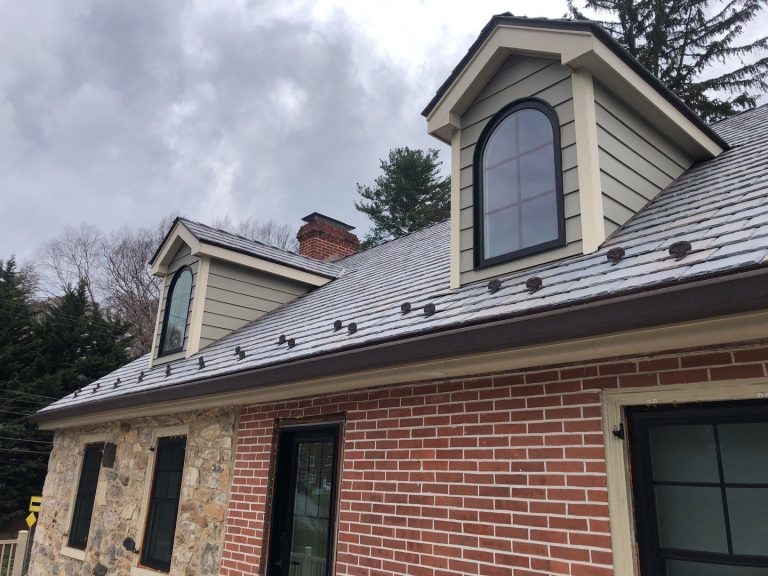
DaVinci synthetic slate roofing is excellent for homes in areas with heavy and frequent snowfall. Homeowners don’t have to worry about snow sitting on their roofs as synthetic slate allows snow to slide right off. So not only are these roofs strong enough to endure ice and snow storms, they prevent snow from laying and gathering on top of houses. However, if snow sliding off your roof is something that concerns you, snow guards can easily be installed for additional safety.
DaVinci synthetic slate roofs are durable enough to endure decades of rough weather conditions without the roof materials wearing down. These tiles are waterproof and don’t absorb moisture, which ensures homeowners won’t experience any issues with warped or expanded tiles when temperatures shift. In addition to these other protective features, DaVinci’s synthetic tiles have a special rib structure that prevents them from curling no matter what weather conditions they’re exposed to.
DaVinci is the top brand in synthetic roofing and has passed tests on material durability for Miami-Dade County, the Texas Department of Insurance, and High-Velocity Hurricane Zones. This brand’s synthetic slate tiles specifically have gotten the best ratings for both impact and fire resistance.
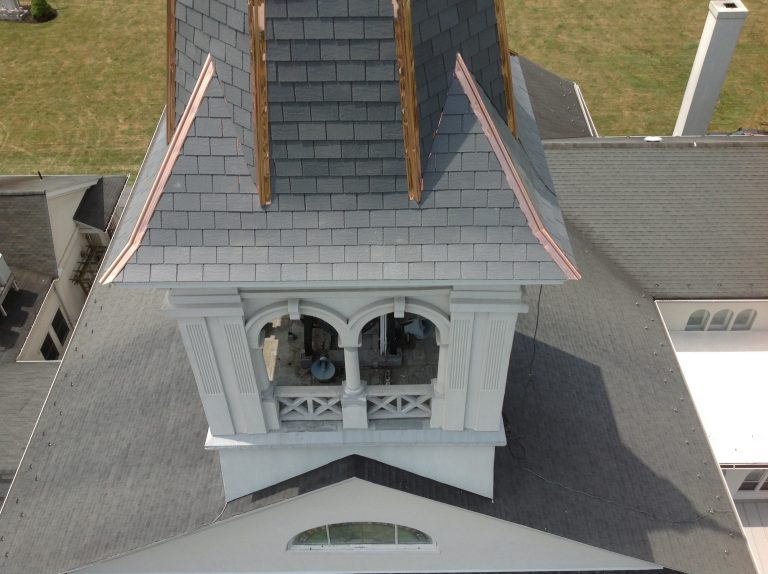
Synthetic slate created by DaVinci has an impact 4 rating, the highest rating for roof durability. This test is done by dropping steel balls on the roofing material to see how well it will withstand hail and impact. Because Impact 4 roofing protects the home against damage and repairs, homeowners with this type of roofing see their home insurance rates lowered and their home value raised. Even in negative temperatures, DaVinci slate tiles don’t crack or break when hit.
These tiles are protected against wildfires and are created with materials that lower the risk of fire spreading. Just like impact damage, DaVinci synthetic slate roofing has the highest rating for fire resistance, a Class A rating. To get this rating, roofs must pass 3 different types of fire activity tests.
First, tiles are subjected to 2 minutes of bursting flames with 2 minutes of rest in between each session. This is done 15 times and in order to pass this test, the roof must come out still functional with the roof deck unharmed.
The next test exposes roof tiles to wind and fire for 10 minutes straight. Again, if there is any sign of the roof being unable to function after this test, it doesn’t pass.

Lastly, the roof tiles are put to the test against a burning brand and wind. The fiery brand is set on the roof tiles for 90 consecutive minutes with air blowing on it. The roof tiles pass this last test if the brand is unable to burn through the roof. To put it simply, Class A fire-resistant roof tiles must resist surface fire-spreading, withstand intermittent blasts of fire, and prevent fire from burning through the roof decking below.
Historical homes have many requirements for new roofing and renovations. Over the years, DaVinci synthetic slate tiles have been frequently approved and used to replace roofs on historic buildings. These tiles are perfect for preserving a historic home’s appearance and functionality as they are lightweight and match in style and color.
Replacing a roof on an old building can come with many problems, including the building not being able to withstand the weight of a new roof. DaVinci synthetic slate roofing is easy to install and light enough to avoid any issues with the building below. Additionally, DaVinci can create custom colors to complement or replicate a building’s unique colors. This is especially beneficial to historic and old buildings where matching colors and maintaining a vintage style can be challenging.
At E&E Contracting, we’ve done many projects featuring DaVinci synthetic slate roofing and highly recommend these beautiful, stylish roofs that last decades. These strong roof tiles are worth the investment and are highly praised by homeowners across the US. Get started on your own project by speaking with one of our roofing specialists and requesting a free estimate.
Engineered stone is a very popular option for people looking for a low-maintenance and natural look for their homes. Stone Veneer is a beautiful alternative to natural stone siding and is manufactured in a way that is easy to install with minimal maintenance. As we discuss engineered stone veneer with our customers we get a lot of questions about the manufacturing process and how it handles the elements.
We choose to use Provia Engineered Stone Veneer which has a tremendous reputation in the industry for durable and beautiful stone veneer. Let’s take a look at how they rigorously design and craft their engineered stone veneer.
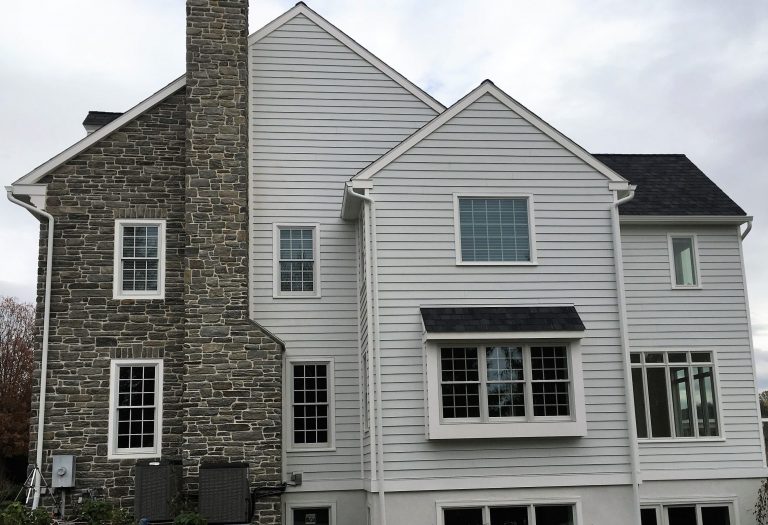
The first step in Provia’s manufacturing process is finding stones in nature. All of Provia’s engineered stones are based on the real thing, and their team is constantly searching for new stones to bring back to their manufacturing facility.
The second step in the process is making casts of natural stones, which Provia uses to make molds for all of their engineered stone. Using natural stones to mold their engineered stone gives Provia’s products shadow and detail that isn’t possible with typical stone veneer manufacturing.
Provia molds are also different because each engineered stone is molded and crafted by a stone mason to create a realistic, handcrafted master mold.
To finish their stones, Provia uses high-quality aggregates, Portland cement, and oxides to create the most realistic character and feel of natural stone. Most stone manufacturers use cheap fillers like sand to emulate the feel of stone but Provia goes above and beyond, using only the best quality aggregates and oxides.
Another huge benefit of Provia’s manufacturing process is that the back of each stone is perfectly flat, allowing for quick and easy installation. This cuts down on cost and allows for a nice, even finish.
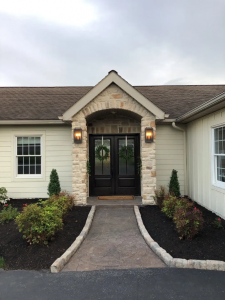
The color of the engineered stone plays an important role in the authenticity of the veneer and the appearance of your home. Provia’s stone veneer colors come in two options that are all inspired by natural stones, including shale, glacier, timber, copper, and more. Their Enhanced Colors include multiple stages of layering on their handcrafted veneers, ensuring that each stone perfectly resembles stones found in nature. Their Premium Enhanced Colors take this process a step further for even deeper colors in each stone, offering unparalleled vibrance and style.
Once you have chosen your stone color and style, it’s time to choose your grout color. Your grout color heavily influences the look of your home; complementary grout colors will soften the contrast of your home while contrasting grout colors will give the stone more pop and create a more dramatic siding.
Are you ready to talk about adding engineered stone to your home? Contact us today for a complimentary estimate, our experienced team would love to speak with you.